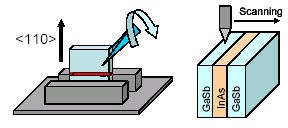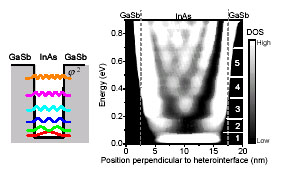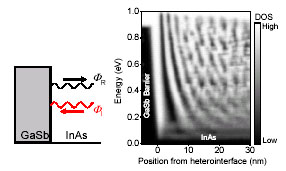Density-of-states Imaging in Semiconductor Heterostructures
Kyoichi Suzuki1, Kiyoshi Kanisawa1, Simon Perraud1,2,
Camille Janer1,3,
Kei Takashina1, Toshimasa Fujisawa1, and Yoshiro Hirayama1,4
1Physical Science
Laboratory, 2CNRS, 3ESPCI, 4Tohoku University
As semiconductor devices develop and become highly integrated with ultra
fine processes, quantum mechanical effects in the devices dominate their
characteristics. Local analysis of the wavefunctions becomes important
for realizing precise device performance. In addition, new physical
phenomena emerging from their nano-scale dimensions are expected.
The scanning tunneling spectroscopy (STS) method, which measures the tunneling
current characteristics using a scanning tunneling microscope (STM), allows
us to investigate the electron density of states (DOS) with nanometer resolution
as a function of the energy, corresponding to the squared wavefunctions.
By scanning the probe, the spatial distribution of the DOS can be obtained.
By performing STS on cleaved semiconductor heterostructure surfaces (Fig.
1), we have succeeded in imaging quantized subbands formed in a quantum
well (Fig. 2) [1], interference of electron waves at an heterointerface
(Fig.3) [2], and wavefunction coupling in a double quantum well [3].
This method can be easily applied to more complicated heterostructures
allowing spatial wavefunction analysis in real devices.
[1] K. Suzuki, et al., Phys. Rev. Lett. 98 (2007) 136802.
[2] K. Suzuki, et al., Jpn. J. Appl. Phys. 46 (2007) 2618.
[3] K. Suzuki, et al., J. Cryst. Growth 301-302 (2007) 97.
Fig. 1. |
Cleaving is performed under ultra-high vacuum (UHV) (<2x10-10Torr) to obtain a clean flat surface. Then, the sample is loaded
into the STM setup cooled down to 4.8 K without breaking UHV. |
 |
|
 |
|
 |
| Fig. 2. |
DOS in an InAs/GaSb single quantum well. Spatial standing wave patterns
corresponding to the confined subbands were observed. |
|
|
| Fig. 3. |
DOS around an InAs/GaSb single heterointerface. Interference patterns
due to the electrons incident on/reflected from the GaSb potential barrier
were observed. |
|
[back] [Top] [Next]


